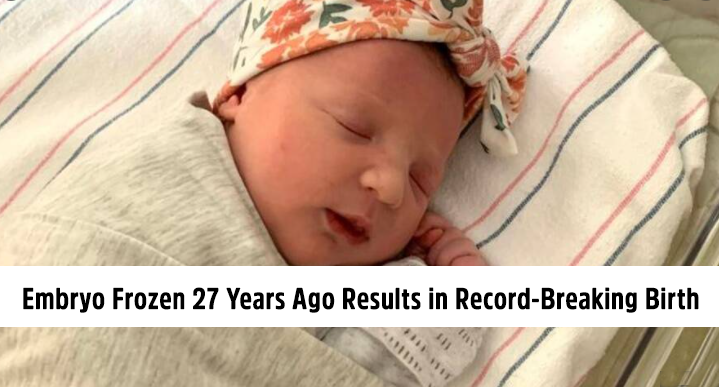
Molly Gibson’s birth in October of this year was 27 years in the making. 27!
You see, her embryo was frozen in October 1992 — when Whitney Houston’s “I Will Always Love You” was at the top of the charts — and remained so until February 2020, when Tina and Ben Gibson of Tennessee adopted the embryo, which is the biological sibling of their current daughter, Emma.
Molly is believed to have set a new record for the longest-frozen embryo to have resulted in a birth, breaking the record set by her older sister.
“We’re over the moon,” Tina, 29, tells BBC. “I still get choked up.”
“If you would have asked me five years ago if I would have not just one girl, but two, I would have said you were crazy,” she said.
The family struggled with infertility for nearly five years before Tina’s parents saw a story about embryo adoption on a local news station.
“That’s the only reason that we share our story. If my parents hadn’t seen this on the news then we wouldn’t be here,” Tina said. “I feel like it should come full-circle.”
Tina, an elementary school teacher, and her husband, a 36-year-old cyber security analyst, reached out to the National Embryo Donation Center (NEDC), a Christian non-profit in Knoxville that stores frozen embryos that in vitro fertilization patients did not use and chose to donate instead.
Families like the Gibsons can then adopt one of the unused embryos and give birth to a child that is, of course, not genetically related to them. There are an estimated one million frozen human embryos stored in the U.S. right now, according to the NEDC.
Mark Mellinger, the NEDC’s marketing and development director, said that experience with infertility is common among families who seek embryo donations.
“I’d say probably 95% have encountered some sort of infertility”, he said. “We feel honored and privileged to do this work,” and help these couples grow their families.
After their first embryo adoption, Gibson gave birth to Emma in 2017, swapping sleepless nights praying for children with the sleepless nights of motherhood. “It’s the best kind of tired and it’s the best kind of exhausted,” she said.
Founded 17 years ago, the NEDC has facilitated more than 1,000 embryo adoptions and births, and now conducts around 200 transfers each year. Similar to a traditional adoption process, couples can decide if they would like a “closed” embryo adoption or an “open” one — allowing for some form of contact with the donor family.
Couples are presented with 200-300 donor profiles, complete with the donor family’s demographic history. The Gibsons had wanted a child for so long that the options were overwhelming–not that they really had any preferences.
“We did not care what this baby looked like, where it came from,” Gibson said. She sought advice from the NEDC where an employee told her to pick something “silly” and go from there.
“My husband and I are smaller people, and so we went through and narrowed it down by height and weight and looked for something similar to ours. That narrowed it down at ton,” she said.
The embryos for both Emma and Molly were donated and frozen together in 1992, when Tina Gibson was just a year old herself. According to the NEDC, Emma’s 24-year-old embryo was the oldest in history to have been born, until Molly came along this year. Not that there seems to be any competition between them.

Emma loves her new little sister, Gibson revealed. “She introduces her to anyone that sees her as ‘my little sister Molly.'” And Gibson has loved seeing the similarities between her girls, including a tiny wrinkle between they’re eyebrows when they’re mad or upset.
According to the NEDC, the shelf-life for frozen embryos is infinite. The time-frame is limited, however, by the age of the technology — the first baby born from an embryo frozen after IVF was born in Australia in 1984.
“It’s entirely possible that there will someday be a 30-year-old embryo that comes to birth,” Mellinger said.




Comments
Loading…